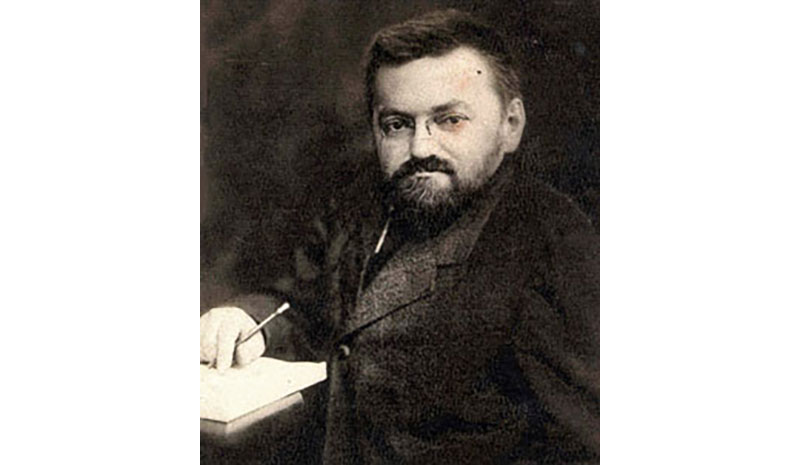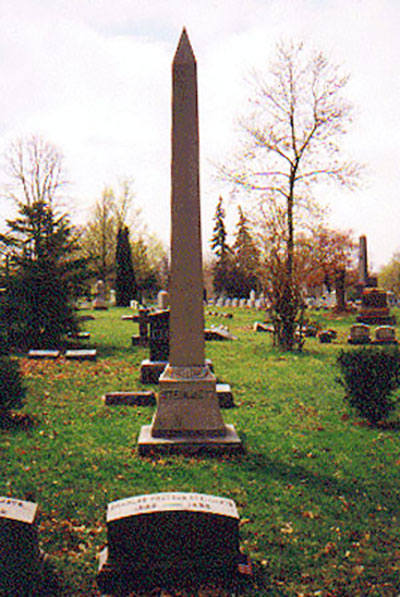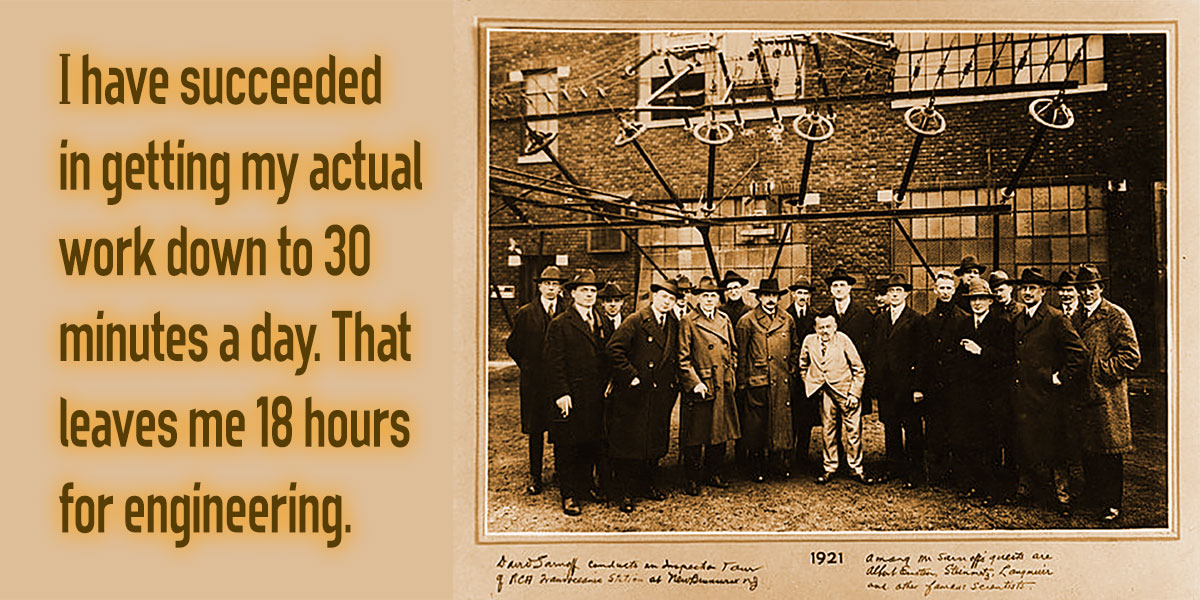Historians often miss inventor’s most important inventions — and even miss great inventors altogether! This was never truer than with Charles Steinmetz. But Eli Whitney and Fibonacci definitely prove my point about historians.
Ask any school child what Whitney’s most notable invention was and they will say the cotton gin when, in fact, he was the father of interchangeable parts — the basis of all modern manufacturing. During the Revolutionary War, the government required a large number of muskets. Hand-fitting and filing each piece in the firing mechanism and trigger would have been a daunting task. Therefore, necessity was the mother of invention and Whitney came up with the new idea of identical, totally interchangeable parts.
Fibonacci invented the mathematical series, for which most know him, but he was the son of a diplomat to Baghdad — a center of learning at the time. He brought Arabic numerals back to early Europe, which the world universally uses today. Previously, Europe used awkward and cumbersome Roman numerals. Very few people know this or credit him with that, just like Whitney’s monumentally important interchangeable parts concept.
The Father of Electrical Engineering

Steinmetz was born Carl August Rudolph Steinmetz in Breslau, Prussia on April 9, 1865. Steinmetz was a hunchback dwarf only four foot three who also suffered hip dysphasia. These hereditary problems perpetuated themselves through three generations of males in his family. This prompted Steinmetz to never marry and have his own children. However, this did not stymie his great humanistic tendencies and intellectual curiosity that impacted the world. Steinmetz later changed his middle name to Proteus, the Greek god who could assume any shape or size, for obvious reasons considering his condition.
A Similarity with Einstein
When he was eight, Steinmetz had great trouble with multiplication tables. However, within two years, he was one of the school’s best students and excelled at math. Incidentally, Einstein was very poor at math early on, only to likewise do a complete turnaround in math and science. Steinmetz attended Wroclaw University, working on his undergraduate degree in 1883. He almost completed his Doctorate by 1888 when German police began investigating him due to his strong outspoken Socialist beliefs.
A Fortuitous Incident
This, along with several influential newspaper articles that he wrote on this subject, forced him to flee to Zürich in 1888. Soon this same behavior pattern prompted him to leave Zürich and to emigrate to America. Steinmetz was almost turned away at Ellis Island. This was because he was a dwarf, and immigration officers considered Steinmetz medically unfit and asked what profession he had to which he answered “theoretical physicist” to the astonished bewildered official. Then, he presented some of his drawings and said “draftsman,” satisfying the official.
A Real Self-Starter
Steinmetz quickly went to work for Rudolf Eickemeyer in Yonkers, NY in a firm making transformers. Almost simultaneously the newly formed General Electric Company tried to hire him. But he remained loyal and grateful to his first employer, until 1893 when GE bought Eickemeyer’s company, along with all of the patents and designs. That same year, Steinmetz made one of the greatest contributions to the field of electrical engineering. He gave a lecture describing the mathematics of the alternating current phenomena. Previously, this was more of an art than a science by those who called themselves electrical engineers. This breakthrough allowed engineers to design electric motors by mathematics rather than by empirical observations and mere trial and error.
This clear presentation of previously muddled, poorly defined and explained mathematical concepts finally simplified AC where all engineers could both understand and use it. It was Steinmetz who first explained impedances by using complex and imaginary numbers, and this is why many call Steinmetz the Father of Electrical Engineering. This work opened the way to the transmission of electric power in useful quantities over long distances.
Solving AC Motor Internal Heat Build-Up
In the same year, Steinmetz’s experiments and papers on magnetic hysteresis (the tendency of a material to resist being magnetized or demagnetized) came to the attention of General Electric. This had a profound implication for its day. It reduced the internal heat build-up in electric motors that had previously greatly shortened their useful lives.
This solution of internal AC motor overheating was somewhat of an accident, like many scientific discoveries tend to be. When Mr. Otis of Otis elevator fame needed a more powerful motor to reach higher floors, Steinmetz designed the motor. With each success, Steinmetz’s fame spread. An example was the nephew of Cyrus Field of Atlantic Cable Car Company approaching Steinmetz’s employer Eickenmeyer. He wanted to propel trolley cars by AC.
The problem was that during the transition from DC to AC, the delay overheated motors due to phase problems. Steinmetz mathematically solved this. His solution became the “Law of Hysteresis” also later known as “Steinmetz’s Law.” Steinmetz explained this Law of Hysteresis in 1891 within The Electrical Engineer magazine. In early 1892, he presented this explanation again in a speech to the American Institute of Electrical Engineers in New York City. By now, GE wanted to hire Steinmetz even more and the only way was to buy Eickenmeyer’s company — much like Bill Gates did with rival companies last decade and continues to do to a lesser extent today.
Buying a Company Just to Get an Employee
In 1894, General Electric moved to Schenectady, NY, and Steinmetz, who was assimilated in the acquisition, was now the head of GE’s “calculating department.” There, he solved mathematical problems that were impediments on projects of his fellow engineers. In his free time, Steinmetz worked on experiments in electrical engineering.
An Unsuspecting Hero
Steinmetz’s indefatigable energy and sheer genius not surprisingly made him a priceless GE asset, allowing him to quickly progress up the corporate ladder. He was not at all a self-serving sort, quite the opposite. But newspapers and the public still became enamored with Schenectady’s scientific wizard. Newspaper and magazine reporters clamored for interviews and photographs of Steinmetz, especially at work. In 1916, he built a lightning generator whose power approached the estimated energy of a real lightning discharge. Newspapers called it the “Modern Jove” and “The Thunderer.”
The advertisement department at GE rode the Steinmetz bandwagon by allowing it to promote electrical home appliances. Steinmetz’s lightning generator mesmerized his generation and helped foster the universal electrification of America.
Steinmetz did not disappoint his faithful following or GE. Before 1900, Steinmetz had applied for over 70 patents on transformers, induction motors, alternators, and rotary converters. By 1900, as GE’s chief consulting engineer, he devoted himself to his research. By 1913, he had 63 patents granted and wrote several textbooks. His classic publication that cemented his claim as the Father of Electrical Engineering was Theory and Calculation of Transient Phenomena and Oscillations (1909). It clearly and definitively explained surges in AC circuits and machines. Steinmetz later commented that this was one of his three greatest technical achievements. The others were his groundbreaking research on magnetic hysteresis and the development of the complex number method.
Steinmetz, the Shunned Humanist
Steinmetz’s contorted, hunchbacked, shriveled torso and enlarged head in proportion to his body always frightened children. Nonetheless, he had a special fascination and fondness for them and their education.
When called to serve on the school board, Steinmetz became an accidental political activist. But like everything else dealt him in his life, he made the best of it. He was instrumental in building more schools to eliminate some students attending school for only half days. He encouraged the hiring of seven nurses and seven part-time doctors, and set aside special rooms for feeding undernourished students. He began the concept of un-graded classes for immigrant children with language problems to lessen the stigma of failing or having to repeat a grade. He also worked to set aside classrooms for learning disabled pupils, and saw that all primary grade textbooks were free.
Steinmetz was Jewish but paid for a present for every Schenectady orphan at Christmas. During his two school board terms, Steinmetz fulfilled the Socialist administration’s promise to provide “One Seat for Every Child” by passing $800,000 in bond issues. This helped build three new schools and enlarged three others. It also helped with free school supplies, more playgrounds, and improved medical care for students. Above all, Steinmetz was a practical man. By 1922, he concluded that America was not right for Socialism since we lacked a “powerful, centralized government of competent men, remaining continuously in office” and because of so few Americans espousing this philosophy.
Outclassed by an Intellectual
Heavyweight Thomas Edison attributed his success to “one percent inspiration and 99 percent perspiration.” But Edison was largely a self-taught individual and it showed when he intellectually challenged Tesla, and especially Steinmetz. Edison argued with Steinmetz that cities should adopt power distribution systems based on DC instead of AC, but any schoolboy knows from Ohm’s Law that current encountering resistance causes a voltage drop. Stringing long wires to electrify cities by DC is a classic example where huge IR drops would have occurred.
A Visionary — Way Ahead of His Time
Steinmetz was a strong advocate of electric vehicles. He was ill-advised though to allow investors to form the Steinmetz Electric Motor Car Co. in 1920. Their intent was to produce 1,000 “industrial trucks” and 300 lightweight “delivery cars.” In early 1922, the company unveiled its first electrical Steinmetz truck and it proved itself in a publicity stunt by climbing a steep Brooklyn hill. In October, the company claimed a five-passenger coupe, but a stockholder discovered falsified production records and then both litigation and corporate collapse soon followed. Steinmetz’s predictions included central air conditioning, television, central power stations, and what really fascinated him was the free powerful clean source of energy from our sun. Fortunately, he did live long enough to witness the electrification of industry and widespread use of both radios and electrical home appliances.
Steinmetz, the Real Character
Steinmetz was a very kind man and once when working in his lab, a person entered and commented on how cold it was and asked why there was no fire in the stove. He replied that he had noticed that a family of mice had decided to make that their home. Steinmetz’s Schenectady home also resembled a zoo with a nest of owls, several alligators, a raccoon, two black crows, a monkey named Jenny, and a temperamental Gila monster. Neighbors also brought him animals that needed to be nursed back to health.
Scorn also knew no retribution in Steinmetz’s mind. He developed a close paternal relationship with his lab assistant. But despite one day accidentally overhearing his assistant’s wife describe him as being physical repugnant, he allowed them to move in with him and even adopted their son as his own. He also built this woman a greenhouse since she greatly fancied flowers. He also populated it with cacti from all over the world and would sit for hours there staring off into space. It was where he said he thought best.
The Ever Present Sense of Humor
After retiring from GE, he taught electrical engineering at that city’s Union College starting in 1902. But GE still frequently used him as a consultant. Despite the most concerted efforts by GE technicians, one very complex system’s problem stubbornly defied solving. Steinmetz laboriously traced the problem to a faulty part and marked it with a piece of chalk. Steinmetz submitted a bill for a whopping $10,000. The appalled and shocked GE managers required an itemized invoice for such a huge bill. So Steinmetz sent back his itemized bill with $1 for marking the chalk spot and $9,999 for knowing exactly where to place that mark. Steinmetz also formed a club, “The Society for the Adjustment of Salaries.” Members played draw poker most of the evening. He also liked to remind engineers that his initials CPS also stood for cycles per second — emblematic of AC — which was his best understood and explained subject.
The Teaching Method Left as a Legacy
Near the end of 1902, Steinmetz became the part-time head of the Electrical Engineering Department at Union. He happily held this position for 10 years, serving without pay. He had the best of both worlds by combining teaching each morning with laboratory work for GE each afternoon at his home.
Steinmetz was ever the humanist, believing that receiving only technical training is not real education at all. Steinmetz always began with simple concepts and evolved on a step-by-step basis toward more difficult and involved ideas. But he failed to realize why all of his students did not immediately understand just how logical his step-by-step approach was.
Nonetheless, he offset this with great patience and the student always came first. He answered student’s questions on their breaks, after class, or even at his home. This made him so popular with students that they made him a Phi Gamma Delta fraternity brother.
An Early Death
Steinmetz died of heart failure on Oct. 26, 1923. By that time, he had amassed over 200 patents. When he died, Henry Ford bought the camp where Steinmetz spent his summers frolicking with friends and especially children. He moved it to The Dearborn Institute in Michigan.

President Herbert Hoover raised $25,000 to purchase Steinmetz’s home and convert it into a museum but after securing the money, the city and state disagreed on who should restore it, so they sadly leveled it 15 years later. New York Governor Alfred E. Smith said, “He always wanted to help everybody.” In 1983, the United States Post Office issued a commemorative stamp in his honor. NV



